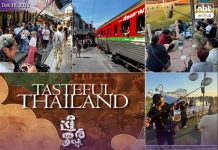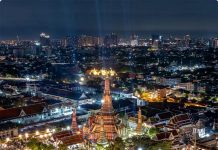In Thailand, we are surrounded by clues that give insights into the way Thai people lived in the past. To learn about golden periods in previous centuries, one must look at ancient cities like Sukhothai, Kamphaeng Phet, and Ayutthaya, where the ruins of many ancient Buddhist temples can be seen. These survive from eras when these cities enjoyed peace and prosperity.
During periods of relative stability, the religious fervour of the city rulers and people found expression in the construction of temples. Wars did occur, but when peace returned new temples would be built. Often, the bigger the temple and the more elaborate its ornamentation, the more peaceful and prosperous the historical period that produced it.
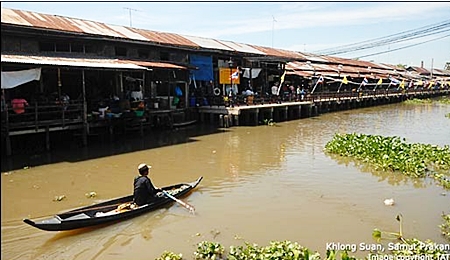
To appreciate the level of artistry that Thai villagers can achieve, women’s clothing is always a good indicator. In the past, these garments were made by housewives who invested personal creativity together with great amounts of time and labour in the creation of incredibly beautiful, authentic folk styles.
To understand lifestyles of the past, shaped and conditioned by the natural environment, turn to Thai traditional dance and folk music. In the North, for example, the dance gestures are slow and leisurely, the music sonorous, giving the impression of an unhurried, relaxed, and humble way of living in an environment where the temperature ranges from cool to comfortably warm. The music of Isan (northeastern Thailand) on the other hand, is fast, exciting and fun — suitable for the end of strenuous farming months when everyone wants to let go and have a good time.
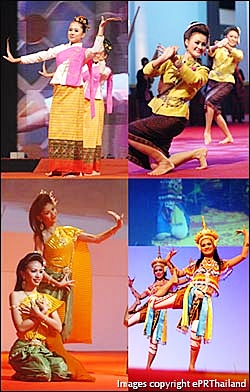
In the Central Region, dance and music follow established conventions because they are heavily influenced by traditions from the royal court. This is in contrast to the forms they take in the South where nature, with its strong winds and changeability, inspires vigorous music for having fun which speeds along under traditional themes.
To get a sense of the way the old and the new co-exist in Thai society, go to an old, long-established community. Old communities, many of which had been in decline for years, are now focal points for both study and touring by the more recent generations of Thais, and as a result they are coming vigorously back to life.
For many centuries, water had a special significance and importance for Thai society and culture. This is not only true of the Central Region, but also nationwide.
In the mountainous North, towns and cities were established beside rivers to give the local people easy access to water for consumption, for agriculture, and for transportation. A river also served as a natural barrier to protect a city from invasion by enemies. In the South, with its long stretches of seacoast, the major cities were established along the shore while smaller towns further inland were set next to rivers that provided transport routes to the coast.
In a society so closely connected to water, the Thais became skilful at all activities related to it — navigating boats, catching food, and recognizing and cultivating edible plants that grew in it or nearby. Many of these plants were highly nutritious, and if the community was large they could be grown not only for household use, but also for sale. They were sold from houseboats called ruean phae in Thai.
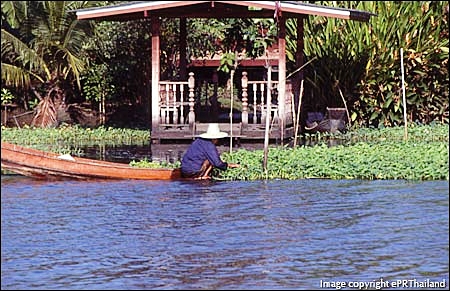
These floating shops would cluster together to form aquatic shopping centres offering all kinds of goods. Some sold kitchen equipment, others agricultural tools or fishing gear, medicine, clothing, fresh or dried food, rice and salted fish. There were even waterborne barbershops.
But for a large group of houseboat shops to be able to form and do business, location was important. The best place was at the mouth of a major canal, perhaps one with many branches, so that local people who lived along their banks would not have to paddle too far to reach them. Trips to these floating markets would be made to buy necessities or to take produce or seafood for sale. As a result these floating commercial centres included boats of all kinds and sizes.
With time, these trading areas evolved into piers for passenger boats that travelled various routes, picking people up along the way. Eventually they also became transfer centres for goods.
Still later, the houseboats started being replaced by buildings on land. At first these were rows of wooden shophouses. The earliest ones were very simple in structure, consisting basically of wooden walls and a thatch roof. Gradually, they became more permanent, with galvanised roofing and paved walkways.
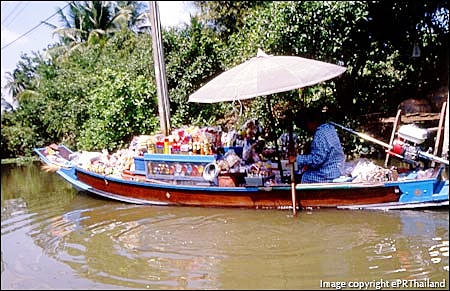
As communities both on the water and on land grew and people from different ethnic backgrounds joined them, the number and range of businesses multiplied and diversified. There would be rice mills, sawmills, religious shrines, mosques, and government offices nearby.
Development continued, and as roads appeared less travelling was done by water. Passenger boats all but disappeared as roads found their way to the old communities. Floating shops vanished completely, leaving commerce to rows of wooden shophouses which also evolved with time, the wooden-walled buildings replaced by sturdier ones made from stuccoed brick with tile roofs and attractive ornamentation.
Change never stops. Wide roads were built to provide direct connection between big cities, and new communities formed and grew rapidly beside them. The old ones located beside water routes shrank and were finally inhabited only by long-term, elderly residents who had stopped working, their children and grandchildren having moved off to newer and more modern communities.
This stagnation in the waterside communities went on for 60 or 70 years until younger generations of Thai in the cities became interested in the roots of today’s society and started making excursions to visit them. Many fell in love with the old-fashioned atmosphere, and some joined forces with community leaders to revive them, carefully preserving and restoring the old architecture and returning the old-style stops and commerce back to life.
Today, once-moribund communities like Sam Chuk in Suphan Buri, Lad Chado in Ayutthaya, the waterside community of Amphawa in Samut Songkhram, Khlong Suan in Samut Prakan, Tha Mai in Chachoengsao are all displaying their distinctive characters once again, thriving in the new atmosphere of cultural awareness and preservation, and giving tourists a warm welcome.
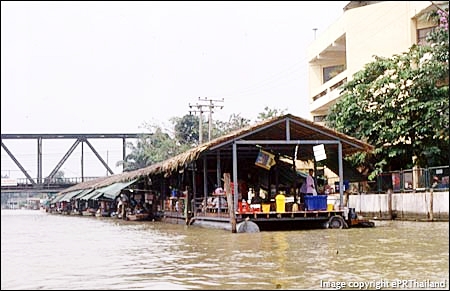
Old communities that formed alongside railway tracks are no less important and interesting than the waterside ones. Trains provided the main form of land transportation before roads were put in to connect Thailand’s big cities. They came into existence more than a century ago through a royal programme of centralization to penetrate the hinterland and connect with remote cities and towns to facilitate effective governance. Once obscure places became accessible and much better known.
Railway lines were laid through all kinds of terrain, some running along rivers or coastlines or through fields and forests. Sometimes it was necessary to dig tunnels through the hills.
Trusted engineers and architects from England and Germany oversaw the planning of the routes that the railways followed as well as their actual construction. Each team was assigned a specific part of the country. The tracks going to Isan were assigned to the British engineers, but once they had reached a point a little past Saraburi province, they were confronted by the area of virgin jungle called Dong Phraya Fai (around today’s Khao Yai National Park). This meant laying track through hot, humid, densely-forested and rather mysterious territory where disease and dangerous wildlife frequently claimed the lives of engineers, architects, overseers and workers. When a British team asked to pull out, Germans took over. The completion of the railway line between Saraburi and Nakhon Rachasima, covering a distance of just over 100 kilometres, took seven years.
The Germans had full responsibility for the railroad to the North. It passed over high mountains and sometimes followed a winding course, with every town and city, large and small, getting its own railroad station. The station buildings were designed to be low but spacious, with a rest area for passengers, a room where tickets were sold, and stretches where the shunting of trains could be supervised. There was also a signalling box. The walkways running around the stations, lined with ornamental plants, and the signs bearing the names of the stations were the same everywhere. The houses built for railroad employees were wooden buildings designed for tropical living.
Large stations for provincial capitals incorporated influences from local architectural styles. The one in Lampang, for example, draws on the traditional architecture of the North. But one station that is in a class by itself is the one at Amphoe Long (Long District) in Phrae Province. It is a small building, set in a valley, designed in a Bavarian style. Maybe the German architects wanted to leave behind a little piece of home.
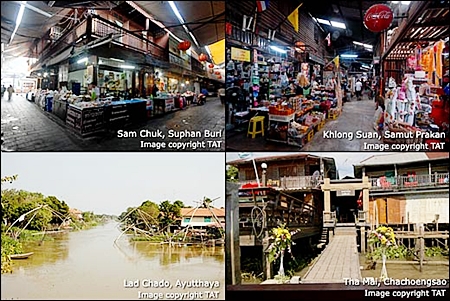
The southern train route, after leaving Bangkok, had to pass through wide fields and orchards and occasionally marshes. It was only by chance that the construction team made one of their biggest discoveries along the way. They came upon a beautiful beach that is today Hua Hin, one of Thailand’s best loved seaside towns.
Most stations were dominated by a row of low, wooden buildings with heavy eaves in front to protect pedestrians from the sun and rain. The hotel would be a two-story wooden structure, and at some stations there was food available for travellers who remained on the train. For example, people departing from Bangkok in the morning would arrive at the Ayutthaya station at around noon, when there would be vendors walking along beside the tracks selling prepared foods to passengers. The offerings might have included fried rice and a boiled egg in a banana leaf container, with khao kriab kung (crispy shrimp chips).
At the same time, travellers heading South would reach the Nakhon Pathom station, where they might be offered khao muu daeng (rice with Chinese red pork and gravy) and khao laam (sticky rice steamed in a bamboo tube with coconut cream). When they got to the Ratchaburi station, which is not far from Nakhon Pathom, they would be able to buy khao phat bai bua (fried rice wrapped in a lotus leaf). All of these foods reflected the character of the local cuisine, and were a familiar part life for travellers of the past.
The train routes to different parts of Thailand are the same ones now that they were then, and the time needed to travel them is the same. None of that has changed. But now, when there are wide, smooth, modern roads linking different provinces using direct routes, travel by train has lost much of its appeal and has been demoted to a second-best alternative. As a result, life in communities along the railway lines have become much quieter. But it is a quietness that has a kind of charm, a special character.
For example, every morning an informal market convenes in the empty area in front of the railway station at Ban Krud in Prachuap Khiri Khan. An array of local dishes are offered there, as well as fresh fish and fruit and locally-made products, all being bought and sold in a cheerful atmosphere. There is a coffee shop where local people sit and chat, and bright colours are everywhere, with the old, wooden shop houses forming a backdrop. The impression is of people leading lively, happy lives in peaceful surroundings.
Then there is the train station in Pranburi, only about 30 kilometres from Hua Hin. Although Hua Hin overlooks the sea, today the province offers all of the modern day conveniences and is not all that much different from Bangkok. But Pranburi is another world, tranquil and shady with old-style wooden houses, a trip back to the Thailand of 50 years ago.
Both of these types of communities, one set beside water, the other beside railroad tracks, reveal different faces of Thai society as it used to be. They challenge visitors seriously interested in the kingdom’s way of life, and how it has changed, to explore and make contact with the Thailand of an earlier era.


